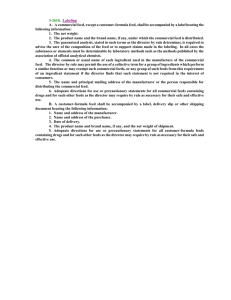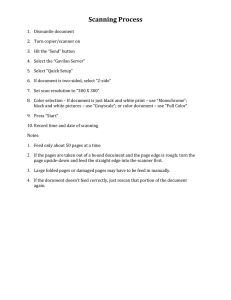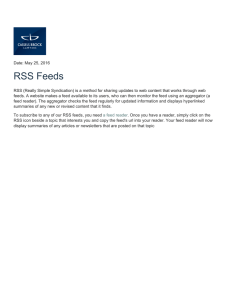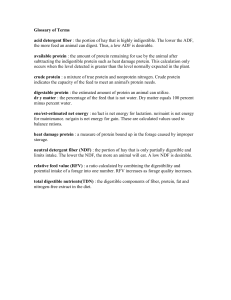CLF262
advertisement
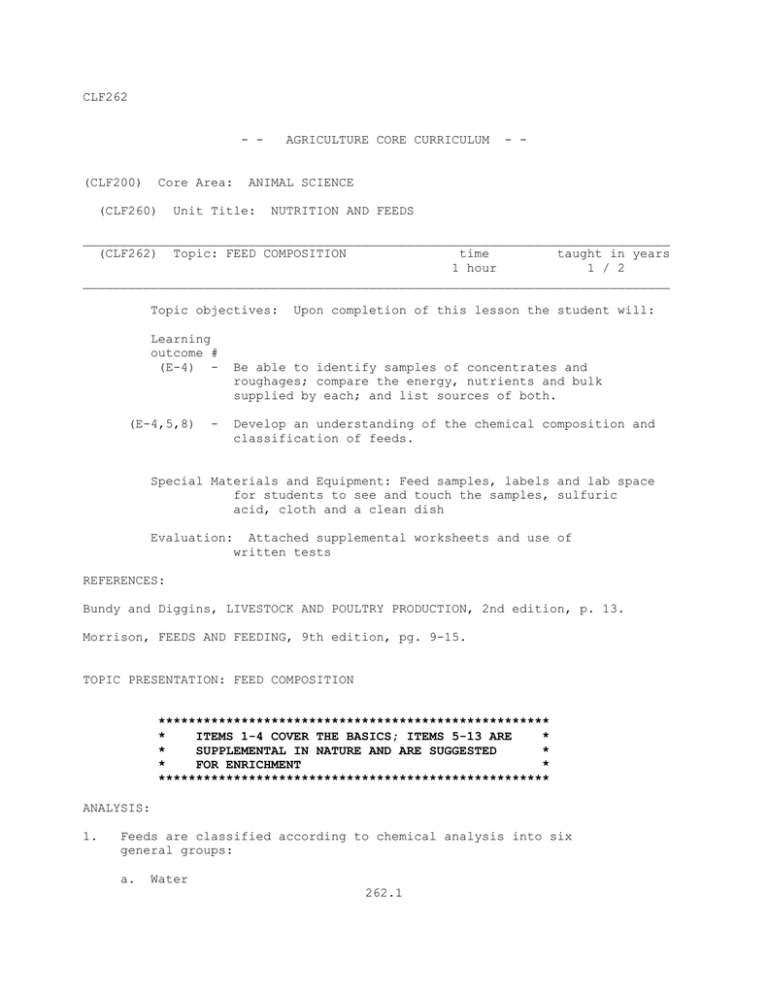
CLF262 - (CLF200) Core Area: (CLF260) AGRICULTURE CORE CURRICULUM - - ANIMAL SCIENCE Unit Title: NUTRITION AND FEEDS ______________________________________________________________________________ (CLF262) Topic: FEED COMPOSITION time taught in years 1 hour 1 / 2 ______________________________________________________________________________ Topic objectives: Learning outcome # (E-4) - (E-4,5,8) - Upon completion of this lesson the student will: Be able to identify samples of concentrates and roughages; compare the energy, nutrients and bulk supplied by each; and list sources of both. Develop an understanding of the chemical composition and classification of feeds. Special Materials and Equipment: Feed samples, labels and lab space for students to see and touch the samples, sulfuric acid, cloth and a clean dish Evaluation: Attached supplemental worksheets and use of written tests REFERENCES: Bundy and Diggins, LIVESTOCK AND POULTRY PRODUCTION, 2nd edition, p. 13. Morrison, FEEDS AND FEEDING, 9th edition, pg. 9-15. TOPIC PRESENTATION: FEED COMPOSITION **************************************************** * ITEMS 1-4 COVER THE BASICS; ITEMS 5-13 ARE * * SUPPLEMENTAL IN NATURE AND ARE SUGGESTED * * FOR ENRICHMENT * **************************************************** ANALYSIS: 1. Feeds are classified according to chemical analysis into six general groups: a. Water 262.1 2. b. Mineral matter or ash c. Protein d. Fiber e. Fat f. Nitrogen-free extract Why do we need to know the composition of livestock feeds? a. 3. 4. Every animal has specific needs for food. This need varies with age, activity level, climate and stage in the production cycle. A knowledge of the amount of the nutrients needed by the body and the value of the feed as a source of the nutrients is the basis for good management and proper diets. This information has been gained slowly through research and trial and error. What is a calorie? a. It is a basic unit of energy. It is defined as the amount of energy needed to raise one gram of water one degree Celsius, measured from 14.5oC to 15.5oC. b. The calorie is used to measure and identify the total amount of energy in a feed. Classes of feeds are divided into and defined as: a. Concentrates - feeds that are low in fiber and high in total digestible nutrients. Example: grains. b. Roughages - feeds that are high in fiber and low in total digestible nutrients. Example: hay. __________________________________________________________ ACTIVITY: 1. Have the students go home and copy the "nutritional information" off of canned and other prepared foods. Have them write the name of the food and the information on the board the following day. 2. Compare the content analysis of canned dog food to that of dry dog food (hint: the biggest difference is water content). Ask the students which is more economical, which provides more energy/pound of food, etc. and discuss the implication for animal management. 3. Bring in samples of grass hay, alfalfa, grains, etc. and have the students identify the item and classify it using the attached worksheet. __________________________________________________________ 262.2 ********************************************************************** * SUPPLEMENTAL INFORMATION (ENRICHMENT) ON FEED COMPOSITION: It is * * suggested that SOME of the following be BRIEFLY introduced to the * * students to assist them in understanding chemical composition. * ********************************************************************** 5. 6. How is dry matter determined (used to determine water content)? a. It is found by determining the percentage of water in a feed and subtracting the water content from 100 percent. b. To find the amount of water in a feed, the nutritionist weighs a finely ground sample, dries it until no water remains, and then weighs it again. How protein content is determined: a. The process of determination is very difficult. The best method is to find the nitrogen content and then multiply the result by 6.25 to give the protein content (since about 16% of protein is nitrogen, and 100% divided by 16% equals 6.25). 7. How fat content is determined: a. 8. Fat dissolves determined by until all fat determine the in ether. The fat ("ether extract") content is "washing" a finely ground sample of feed with ether is gone; after this process by weight change you can percentage fat in the feed. How fiber is determined and importance of fiber content in feeds: a. The percentage of fiber is found by boiling a sample of feed successively in weak acid and in weak alkali, after which the dissolved material is washed out. Before and after weighings are done to determine the amount of fiber (by %) removed. b. It is important to know the fiber content. Feeds that are high in fiber are less digestible and therefore less nutritious (and provide less energy) than those lower in fiber (for example, the higher the fiber content in alfalfa, the lower its digestibility). ___________________________________________________________ ACTIVITY: Obtain some sulfuric acid and demonstrate what a weak solution will do to a piece of cotton cloth to demonstrate the dissolving of fiber. ___________________________________________________________ 9. How mineral content is determined and percentage in roughages and concentrates: 262.3 10. 11.. a. The percentage of mineral matter is determined by burning a sample of feed until it is free of everything but the minerals (calcium, iron, phosphorus, etc.). The bulk of the weight burned away will be carbon. b. Roughages are higher in mineral matter because of the accumulation of minerals in the leaves during growth, soil washed upon the growing plants by rain, and dust settling on the roughage before it is stored. How nitrogen-free extract (NFE) is determined: a. The percentage of NFE is found by difference and not by actual analysis. It is the weight of the substance less the protein (where most of the nitrogen is found). b. The percentages of water, ash, protein, fiber, and fat are added together and the sum subtracted from 100%. Does protein determine a feeds classification? a. 12. 13. No, a concentrate may be either low in protein or rich in protein. Composition of plants and animals: a. Walls of the body cells of animals are made chiefly of protein and the walls of plant cells are composed of cellulose and other carbohydrates. (Remember, plants do have a cell membrane inside the cell wall.) b. In plants, the reserve food is stored as starch, and in animals the reserve is stored in the form of fat. c. Plants can use energy supplied by the sun to build inorganic matter taken from the earth and air into organic compounds. Animals cannot directly secure the energy necessary for their life from the sun, and must live on the organic energy-rich compounds built by plants, which can capture solar energy. Changes in chemical composition of animals: a. The percentage of water decreases as the animal grows and fattens. b. The percentage of protein remains fairly constant during growth but decreases as the animal fattens. c. The percentage of fat increases gradually during growth and more rapidly during fattening. d. The percentage of mineral decreases as the animal fattens. e. The changes in composition are due chiefly to the accumulation of fat in the body. 262.4 Supplemental Worksheet #1: Feed Composition Name________________________________ Date__________________ Class__________________ Name of Feed | Concentrate | High or Low | High or Low | or Roughage | Energy | Digestibility _________________________________________________________________________ 1. | | | | | | | | | | | | _________________________________________________________________________ 2. | | | | | | | | | | | | _________________________________________________________________________ 3. | | | | | | | | | | | | _________________________________________________________________________ 4. | | | | | | | | | | | | _________________________________________________________________________ 5. | | | | | | | | | | | | _________________________________________________________________________ 6. | | | | | | | | | | | | _________________________________________________________________________ 262.5 Supplemental Worksheet #2: Feed Composition Name____________________________ Date_________________ Class________________________ 1. Into what six groups or classes are feeds grouped according to chemical analyses? 2. What is a calorie used for? 3. Why is it important to know the chemical analysis of a livestock feed? 4. How is the percentage of dry matter of a feed determined? 5. How is the protein content of a feed determined? 6. How is the fat content of a feed determined? 7. How is the fiber content of a feed determined and why is it important to know the fiber content of various feeds? 8. How is the mineral content of a feed determined and why are roughages higher than grains in mineral content? 9. How is the percentage of nitrogen-free extract in a feed determined? 10. Into what two classes are feeds divided? Distinguish between the two classes. 11. Does the amount of protein in a feed determine its classification as a concentrate or a roughage? 12. What are the differences in plants and animals in (a) basic cell structure; (b) the storage of food; and (c) their sources of energy? 13. What are the changes in chemical composition of animals as they grow and as they fatten? Discuss the percentage of water, protein, fat, and mineral matter. 262.6
